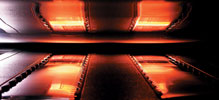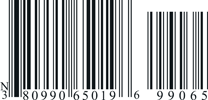

2D imaging scanning technology can enhance profit, efficiency and customer service.
Breakthroughs in today's 2D image scanning technology enable high performance linear barcode scanning, equal to that of lasers and linear imagers.
2D image scanners deliver a level of value-added functionality beyond what other AIDC technologies can provide, including point-and-shoot reading of PDF (commonly found on drivers' licences) and 2D barcodes, plus digital image capture capability.
By leveraging common elements, such as a customer's driver's licence in conjunction with the capabilities of a 2D image scanning solution at the point-of-service (POS), retailers can greatly enhance customer service, streamline processes and perform profit-enhancing functions.
The ability to utilise and benefit from 2D capabilities at the POS is a proven reality today.
Turn POS into a competitive advantage
New POS application demands and recent performance breakthroughs in (two-dimensional) 2D image scanning technology are breathing new life and new profit opportunities into POS operations. Today, through the advanced capabilities of 2D scanners, retailers have a non-disruptive path with clear ROI drivers to deliver new levels of productivity and customer service to the POS.
The migration from single functionality scanners - those that can only read a linear barcode - to 2D image scanners, enables retailers to use a single device to achieve their requirement for fast and accurate barcode scanning. It also allows them to extend their capabilities at the POS through the automation of services such as forms fill, age and ID verification, and transaction tracking. By eliminating paper-based processes and manual data entry, retailers gain the advantage of offering more service in less time while they already have the customer engaged.

Why are major industries moving to 2D?
Historically, laser scanners and linear imagers have been the predominant choice by retailers for their point-of-service operations. With linear barcodes deeply embedded in the retail workflow for item-level labelling, these solutions have proven to be more than adequate for use at the POS.
Meanwhile, other markets such as government, transportation, manufacturing and healthcare have evolved from linear-only scanning to solutions based on 2D image scanning technology in an effort to help them more effectively capitalise on their data collection programme while delivering enhanced levels of service to their customers. Regardless of your industry, 2D image scanning affords you the ability to do more and provide greater value with a single scanning device.
2D image scanning technology provides omni-directional point-and-shoot reading of any type of barcode - linear, PDF and 2D - with a single device. The scanner does not have to be perfectly aligned with the target barcode, enhancing ease-of-use and user efficiency.
The on-demand flexibility and powerful software assets of 2D image scanning technology protects your investment from changes in barcode symbologies or other data collection requirements because it is always ready to accept new data input, eliminating the need to invest in new hardware when applications change.
* 2D digital capabilities enable image capture for processing and storage of data - extending the boundaries of the information an organisation can utilise and manage.
* 2D barcodes allow storing more data in a smaller amount of space - this has been critical in enabling organisations to track and manage more data in an effort to enhance their levels of customer service and improve operations.
Historically, a more expensive niche technology, 2D image scanning has evolved to deliver the right combination of performance and value for any organisation looking to improve productivity, profit opportunities and customer service.
High-performance linear reading makes 2D image scanners a true retail solution
The speed of early 2D image scanners on linear barcodes was considered unacceptable by many retailers based on their need for fast customer throughput at checkout, and this typically outweighed all of the technology's other unique benefits. However, this gap has narrowed significantly, to the point now where the performance difference has been eliminated. Enhancements in imaging technology including improved lighting and optical sensitivity have provided increased performance in two key areas that relate directly to ease-of-use in the retail environment:
Improved distance reading - once only capable of scanning from a few inches away, 2D image scanners now have the depth of field required for retail applications.
Increased motion tolerance - the latest 2D image scanners feature motion tolerance (the ability to quickly read barcodes regardless of operator hand movement) up to and exceeding 20 inches per second - compared to 2 inches per second just three to four years ago - as fast as traditional laser presentation scanners.
In addition, the omni-directional reading capability of a 2D image scanner makes it ideal for both handheld and presentation or fly-by scanning applications.
Leveraging the driver's licence to meet real-world retail demands
The extended value of a 2D image scanner lies in its ability to be more than just a scanner. Drivers for more capability at the POS are coming from two main areas; within the retail environment from a desire to increase customer service and profitability by automating time-consuming processes, and from organisations outside of retail such as US and state governments that have passed legislation requiring retailers to comply with levels of data tracking to monitor and control the sale of specific items such as alcohol, tobacco and pseudo ephedrine.
In each of the aforementioned cases, 2D image scanning technology can help the retailer accomplish their goal through leveraging a common identity instrument already in place - the driver's licence.
Currently, 44 US states and seven Canadian provinces use a PDF417 barcode on their drivers' licences. These codes commonly contain all of the information shown on the front of the licence. Therefore, the ability to scan the back of a driver's licence and electronically utilise that information can eliminate the time consuming task of manual data entry by the store associate, or the requirement for a customer to manually fill out extended forms. This capability can have tremendous impact on a variety of different applications:
Automated forms fill - turning paper forms to 'e-Forms' by auto-populating customer information with a single scan of a customer's licence. Automating this process can help break down the barrier of a customer's hesitance to wait for additional services once at the POS. Additionally, speeding this process can help eliminate long lines at checkout or the customer service desk while attempting to offer these additional services. Using the example of a store credit card application, just a few more applicants per month can have significant impact on a store's revenue.
Age and ID verification - eliminating the need for associates to key in customer birthdates for the sale of alcohol, tobacco or other age-controlled products. By scanning a single barcode, ID information is electronically gathered, verified and recorded in an automated method, enabling you to more thoroughly verify identification and avoid non-compliance fines or penalties.
Electronic tracking of transactions - in instances where recording customer purchase history is required, such as with the recent federal mandate requiring retailers to track the sale of products containing pseudo ephedrine.* Scanning a single code on the customer's driver's licence can electronically record the necessary customer information while scanning the package records the drug and quantity - both are logged electronically, simplifying storage and retrieval of all data and streamlining the frontline process.
How could taking a digital picture benefit POS operations?
Creative retailers are also using 2D imaging technology for applications beyond barcode reading for even greater flexibility in the information they are able to capture and store electronically. The point-of-sale, customer service desk and the pharmacy counter all afford great opportunity for leveraging a 2D solution's image-capture capability for increased efficiency.
As an example, pharmacy prescriptions are typically filled using a paper script brought in by the customer, which then must be stored in hard copy. Consider taking a digital picture of the script instead. Using a 2D image scanner, the paper script is captured electronically at the counter, and then processed and stored electronically - resulting in a paperless workflow and simplified storage and retrieval.
This capability can be extended anywhere in the store where there is a paper-based process in which critical information needs to be stored.
The advantages of 2D image scanning technology are being applied by organisations large and small, and across a broad range of markets.
Unlike other technology solutions such as RFID or biometrics where true viability is still to be seen and requires extensive infrastructure change and investment - 2D image scanning is time-tested, its form and function is familiar to both operators and customers, and it requires no workflow process changes.
The value of a 2D image scanning solution is only further enhanced by the fact that it is ready to perform new applications as your requirements emerge. One piece of hardware can handle all of the basic POS barcode scanning requirements you have today, and also has the on-demand flexibility of being able to perform advanced 2D and image capture applications when you need them-extending the life of your solution and greatly increasing the overall return on investment.
*The Combat Methamphetamine Epidemic Act of 2005 (US) limits the monthly amount of any product containing pseudo ephedrine an individual can purchase, requires the purchaser to present photo identification prior to purchase and requires the retailer to maintain personal information on the purchaser for at least two years.
For more information contact Honeywell Security, +27 (0)11 695 8016, www.honeywellsecurity.com

© Technews Publishing (Pty) Ltd. | All Rights Reserved.